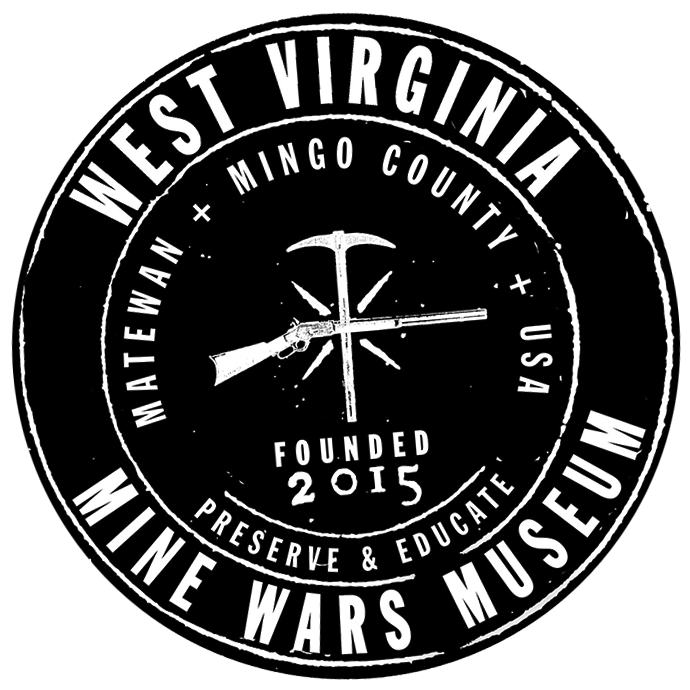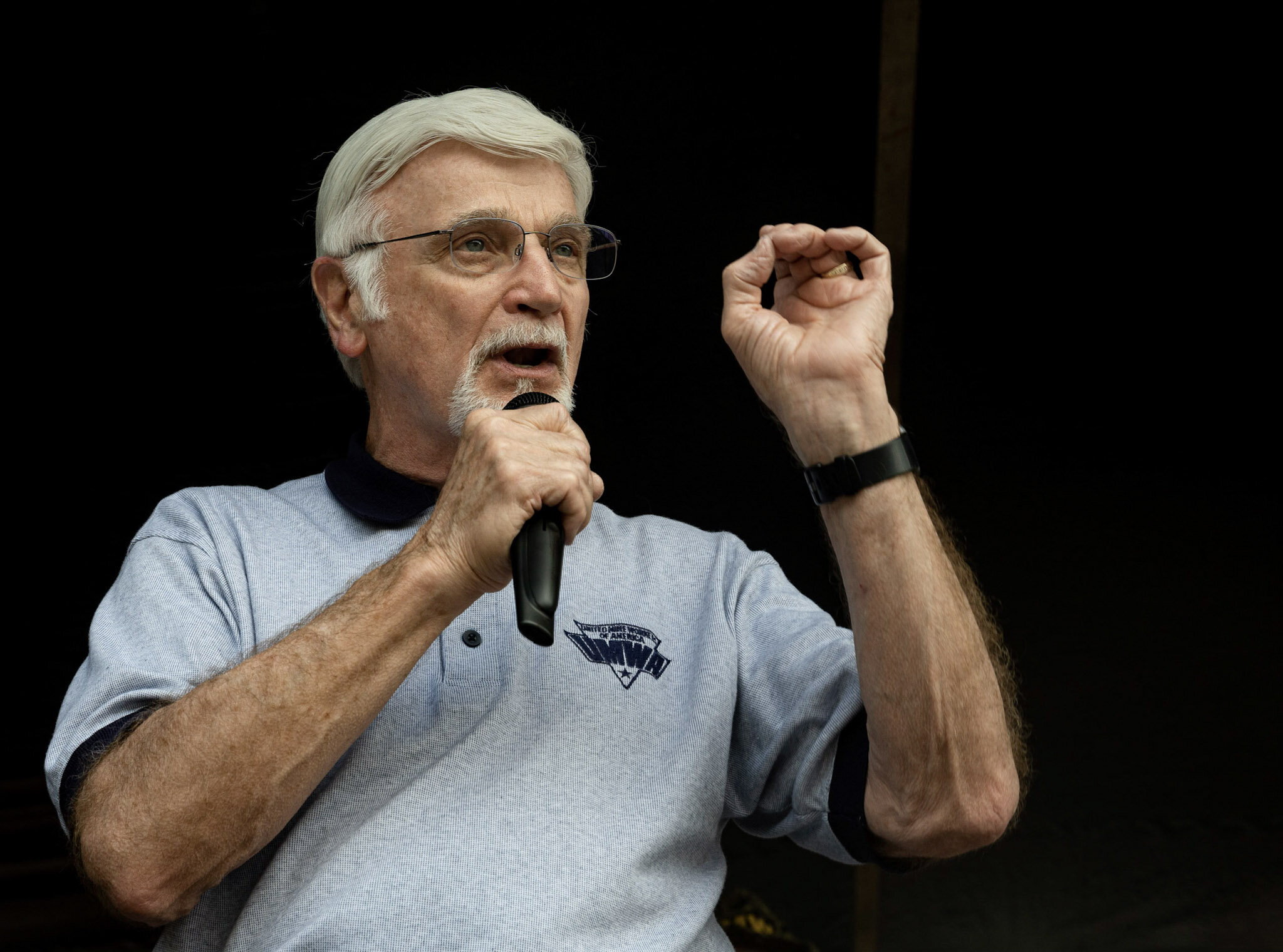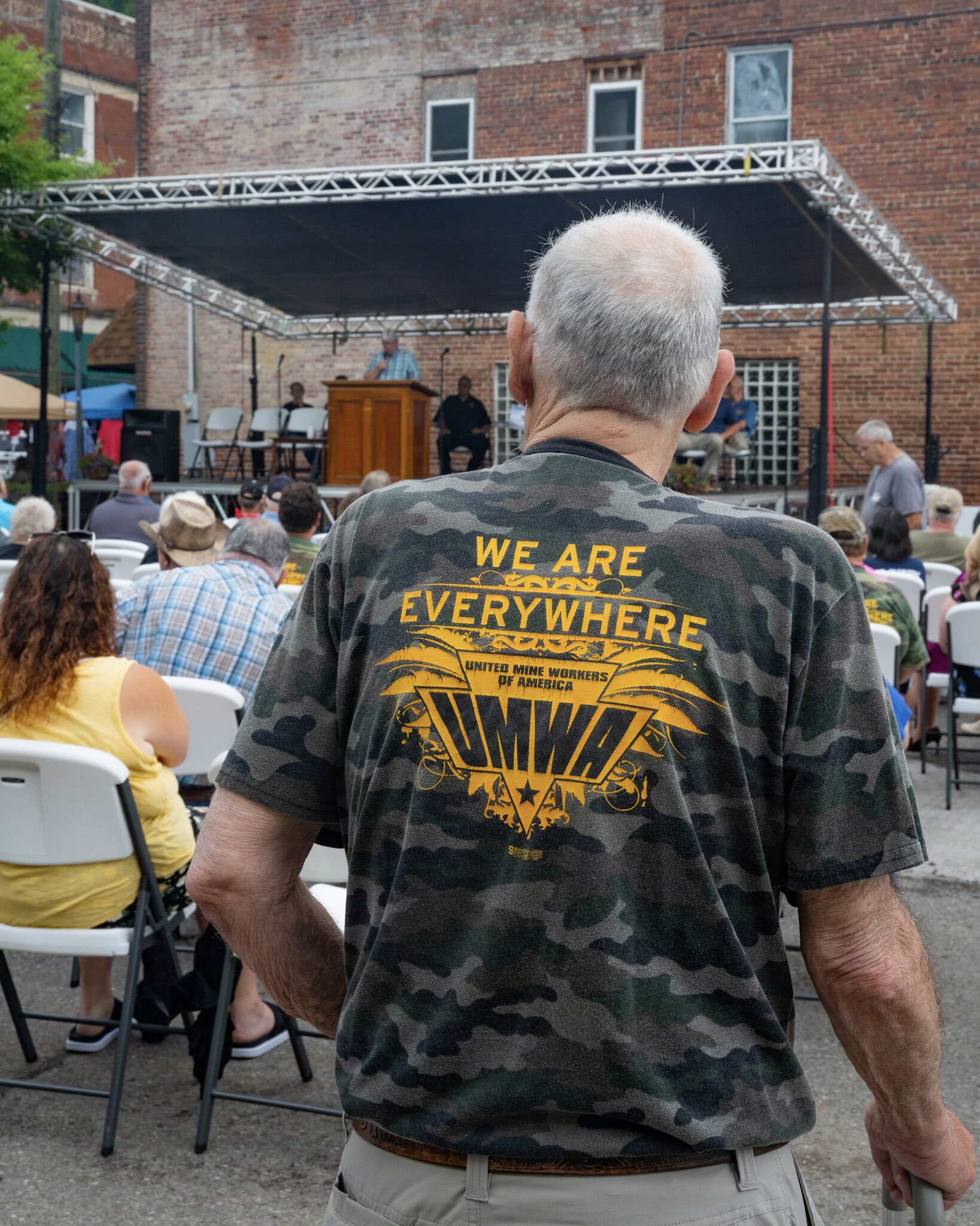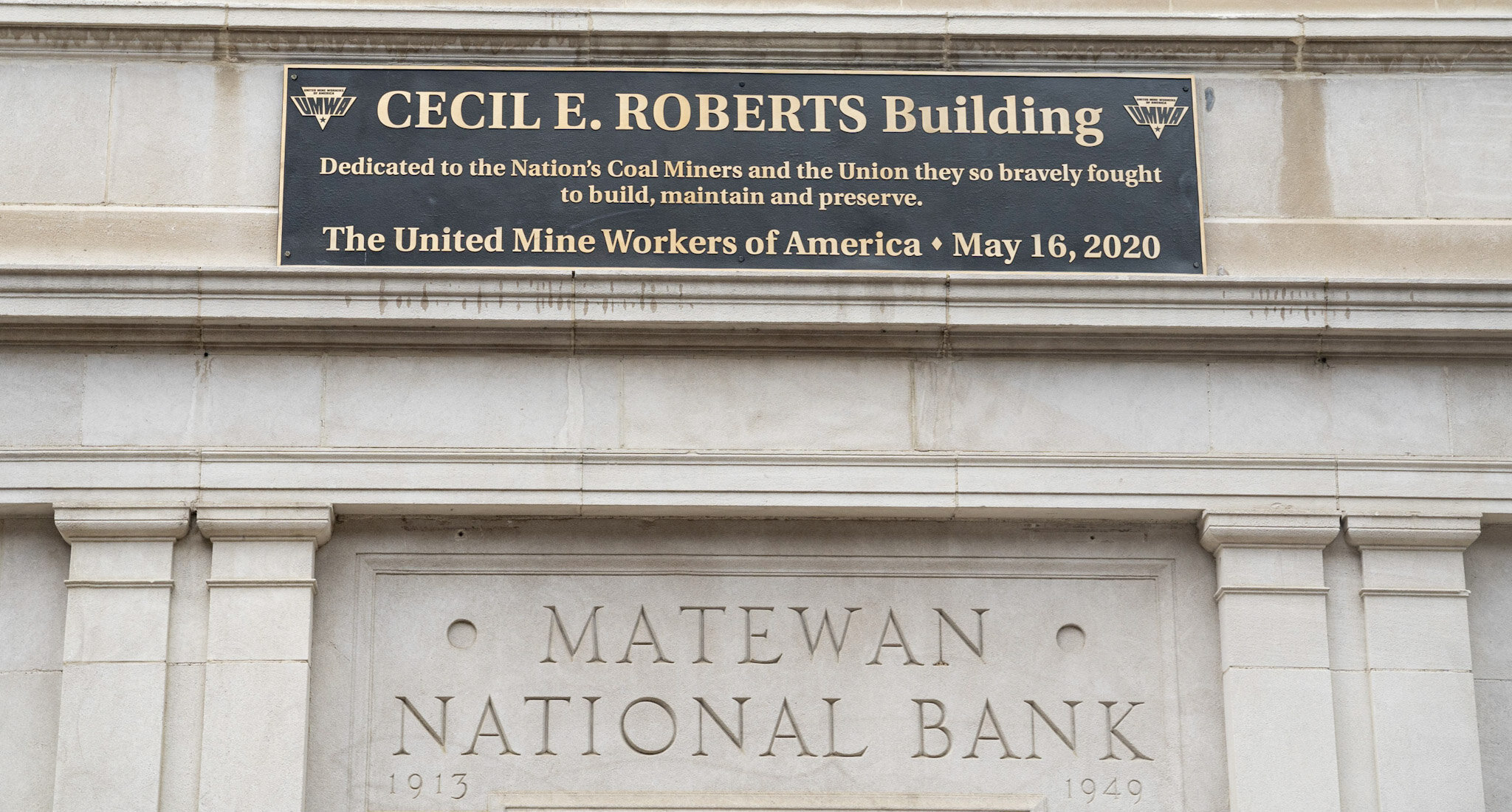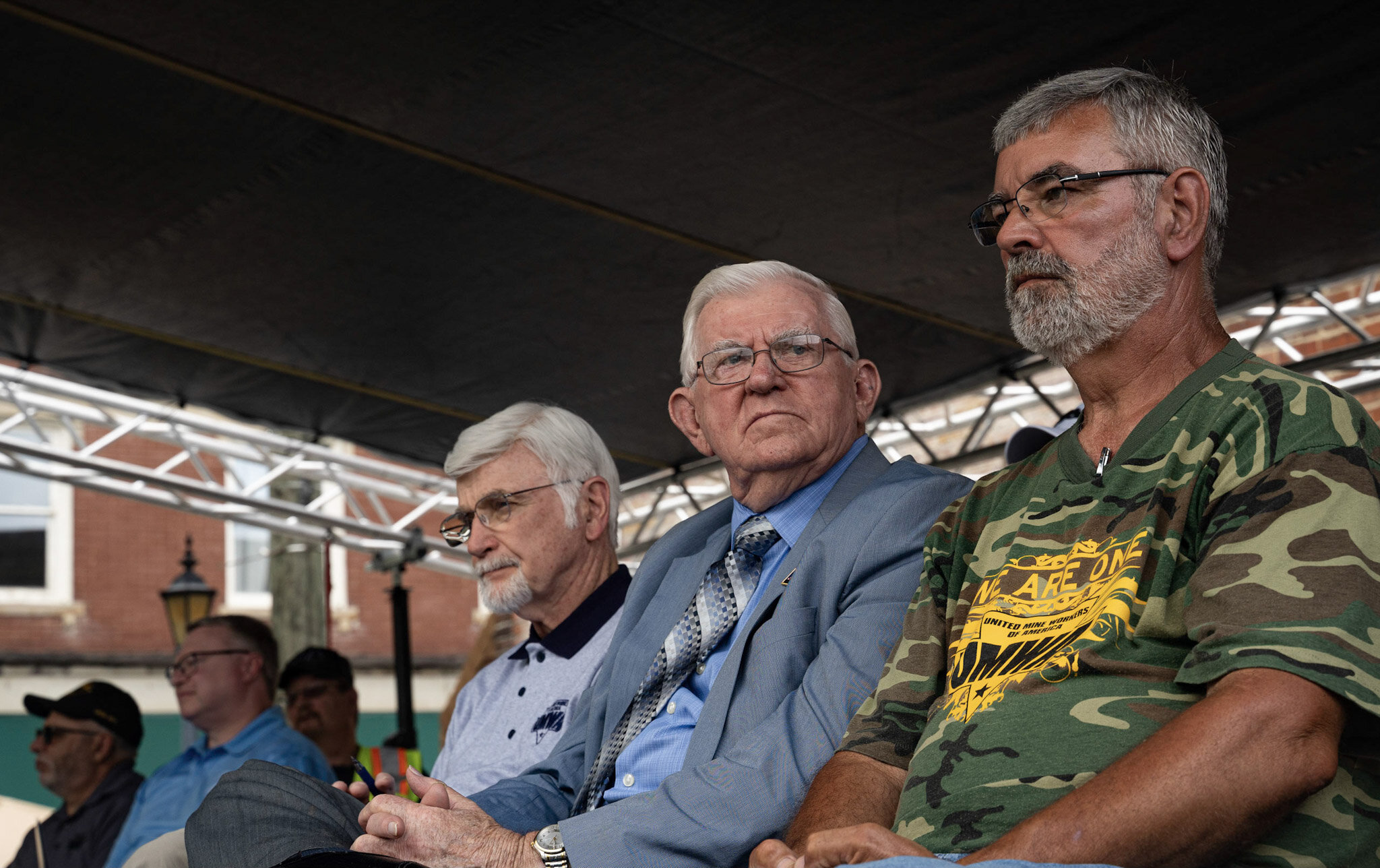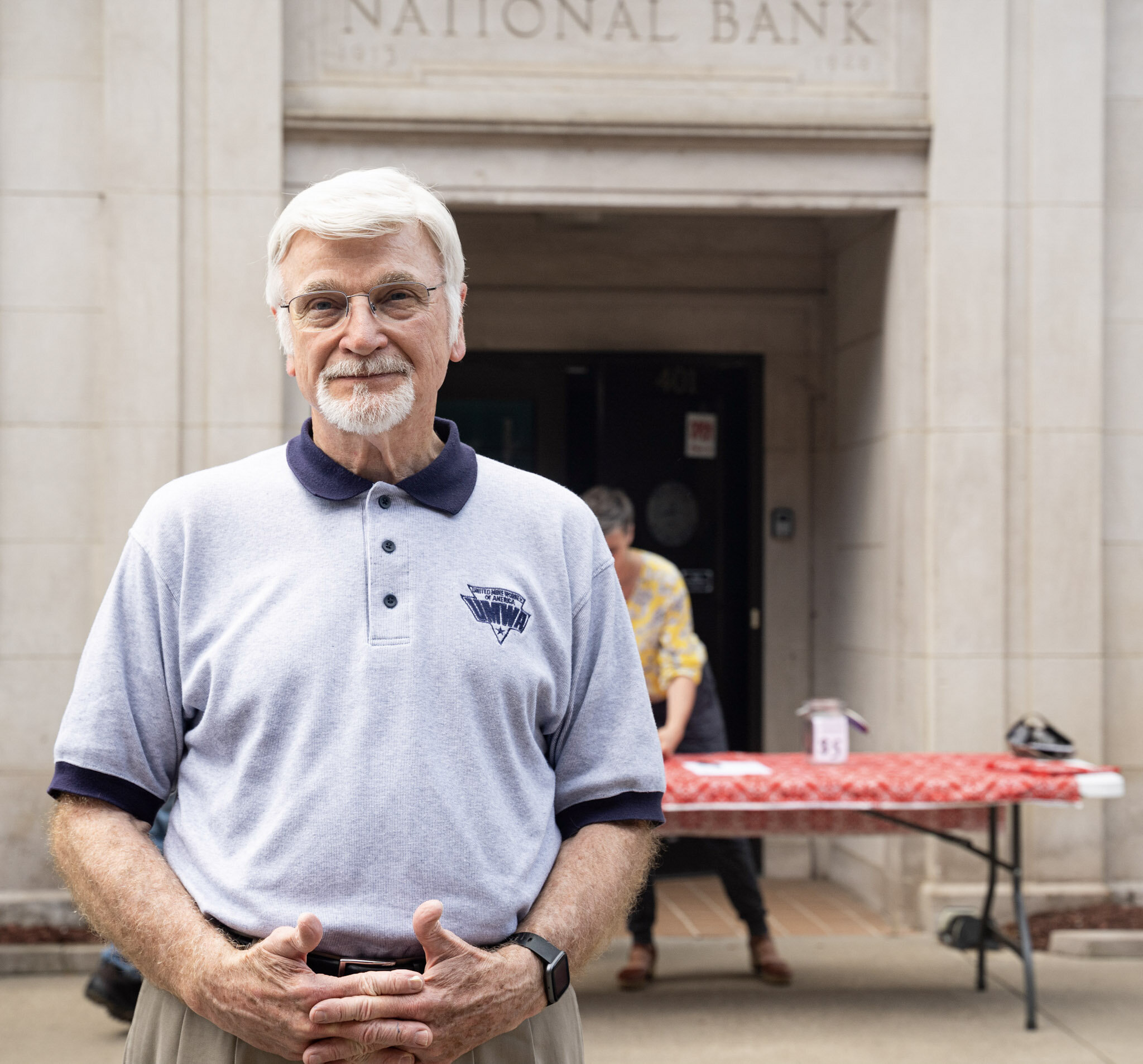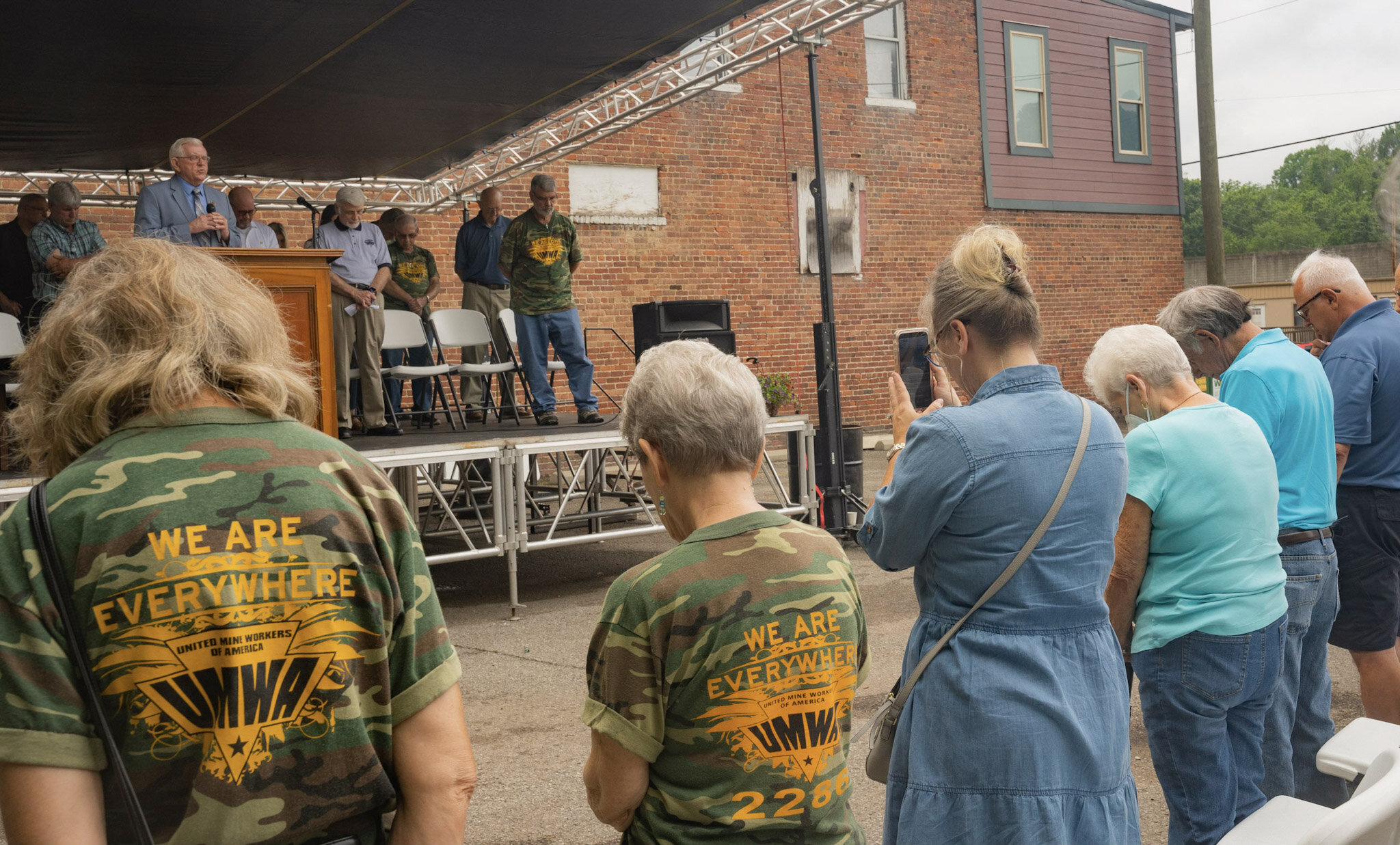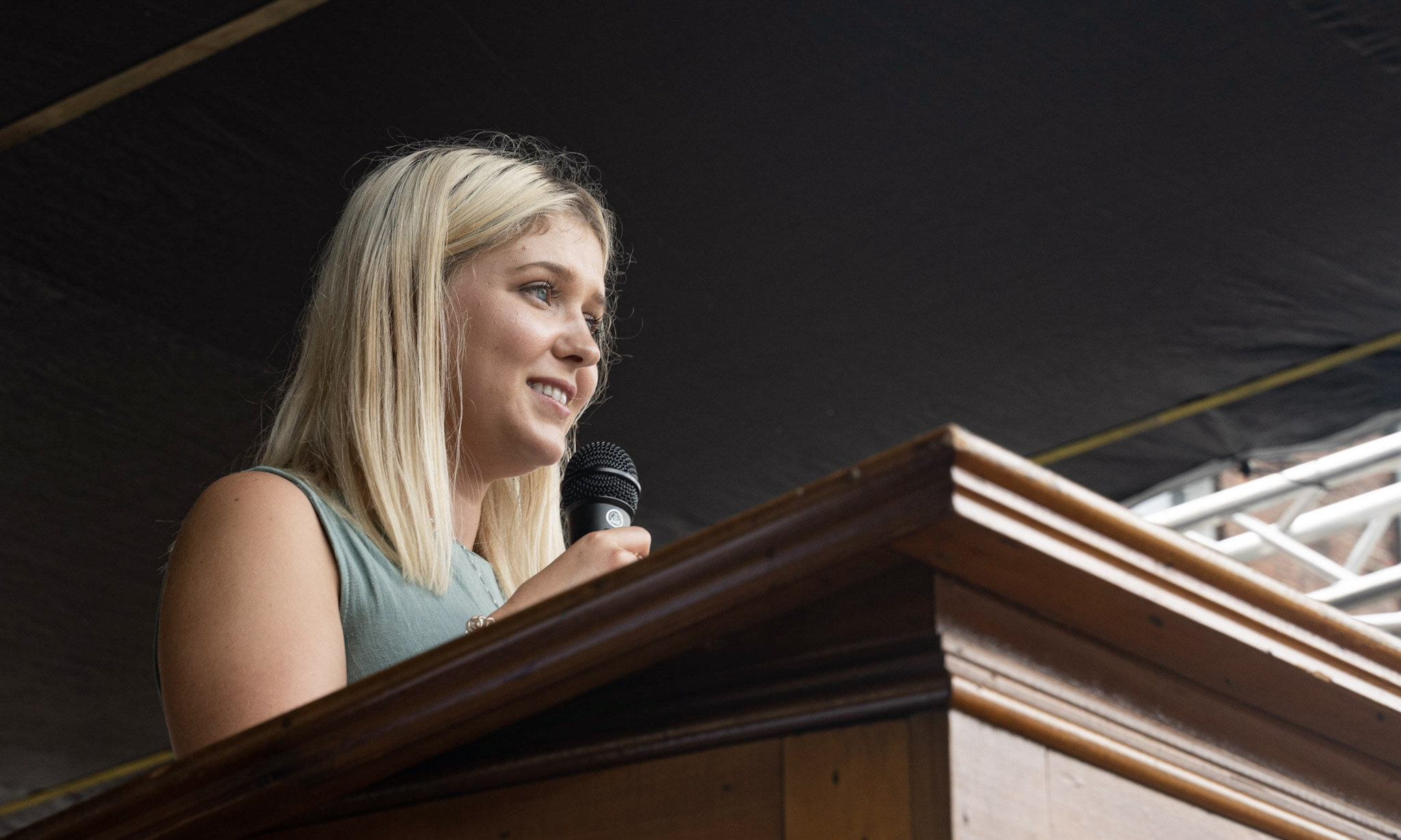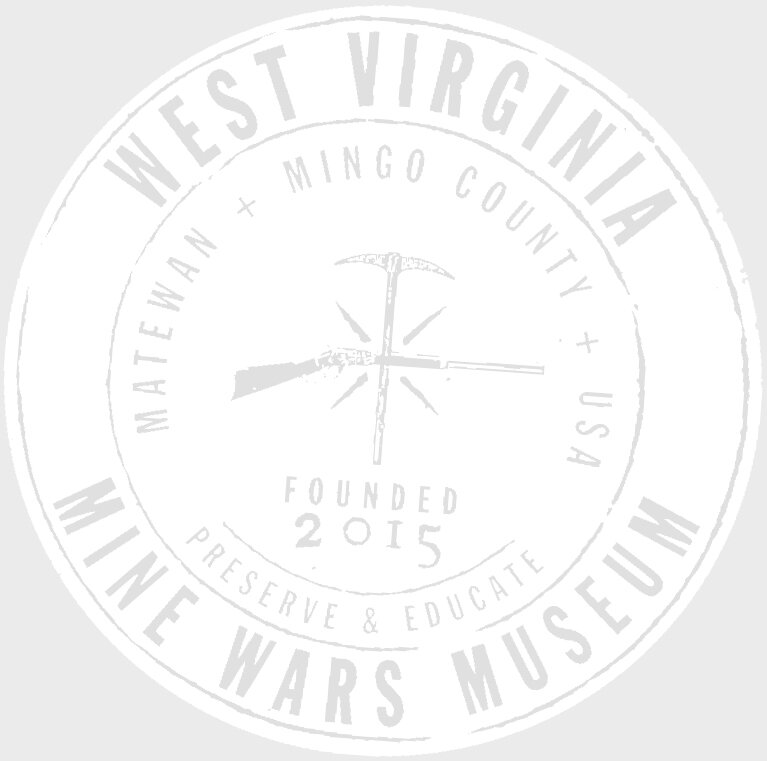On June 12, 2021, UMWA Local 1440 named the building at 401 Mate Street, where the museum is located, the Cecil E. Roberts Building in honor of the president of the United Mine Workers of America for his many years of service in the American labor movement, and especially his efforts to help Local 1440 secure their pensions and healthcare.
At the dedication ceremony, Museum Director Kenzie New Walker presented President Roberts with a gift, explaining, "It's a special print of bullet casings that were unearthed by Kenny King at the Blair Mountain Battlefield, and we hope it finds a place in your home or office for folks to be reminded: coal miners had to fight.” A copy of Kenzie’s speech can be found below.
Thanks to the officers of Local 1440, Hawkeye Dixon, Danny Whitt, and Frank Collins, and the membership of Local 1440 for making today possible and hosting the Cecil Roberts building dedication ceremony. What a journey it has been to get to this day! So many folks have given so much of their time, efforts, and well, money, to make this day possible. It’s a great honor for the Mine Wars Museum to be a part of it and I appreciate y’all having us.
Without a doubt, the West Virginia Mine Wars Museum would not have been possible if it weren’t for the United Mine Workers of America.
Over six years ago, the Mine Wars Museum opened in May of 2015, right across the street here, setting out to uplift efforts to unionize southern West Virginia during the Mine Wars. President Roberts spoke at the museum’s grand opening and said, “I never read about Ludlow, I never read about Paint Creek, and I never read about Cabin Creek in my history books. And young people today, they don’t either.” He continued, “I submit to you that it is time for working folks not only to stand up and fight back and keep the middle class…it’s time to stop the millionaires and the billionaires telling us what our kids can read and learn in the schools.”
We have often repeated President Roberts’s words, and they inform the museum’s mission. The Mine Wars are a critical chapter in the story of the national labor movement, culminating when 10,000 miners banded together in a multi-racial, multi-lingual army to fight for their rights as American citizens. This included the right to form a union. Union miners wore red bandanas around their necks as they marched and engaged with strikebreakers and the federal government during the 1921 Battle of Blair Mountain after decades of organizing efforts in the southern coalfields.
And yet, this is a story that is left out of our state and nation’s history books. Instead, these stories were passed around kitchen tables and front porches for families to hear. This is how this history was first passed down to me, listening to my Mom and Dad tell me stories about the struggles to form a union, and the struggles to get by before there was one. I’m proud to be the daughter, granddaughter, and great-granddaughter of union coal miners, and come from a union family. Coincidentally, both of my great grandparents on both sides of my family knew each other long before my parents were born: they lived together in a coal camp in Omar in the early 1930s where they worked in the mines.
But for others, they didn’t learn about it through their family members or friends. They didn’t learn about it all, and these stories were absent from their school curriculum or were just a passing reference. And this history wasn’t easily accessible to the public.
The Museum was a grassroots effort to share and preserve this story of unionization, struggle and tremendous sacrifice, and class solidarity in the coalfields of West Virginia. To make sure that history was included in today’s classrooms, we started hosting field trips and traveling to classrooms to teach a new generation about the power of standing together, and we handed out red bandanas while doing so. Working with local teachers, we built out a curriculum and a teachers’ resource guide for 4th, 8th, and 11th grade classrooms--one that we continue to refine and redevelop to suit the needs of those we serve to teach a powerful union history.
We also create special programming for descendants to share personal stories publicly, to commemorate anniversaries like the 30th anniversary screening of the film Matewan, the 100th Anniversary of the Battle of Matewan, and the upcoming Blair Centennial set for Labor Day Weekend this year. We also began publishing the official Mine Wars Museum Journal: In These Hills.
All along the way, we have received support from the UMWA--from the international office, from Local 1440, and from UMWA members. I still remember when Danny Whitt, secretary of 1440 called me. He is someone who happens to be just about everywhere, always working for the local and supporting the museum in all our efforts. He called me with an invitation for the Mine Wars Museum--it was an invitation to move the Museum into their building.
Local 1440 had just purchased this building before us today, previously the Matewan National Bank and then BB&T Building, and they had an incredible, bold vision for what this space could be to continue to serve the community of Matewan. How would we accomplish it? Just like we always have. We accomplished it by working hand-in-hand with the United Mine Workers, including the International, Local 1440, and other locals from around the region.
I’d like to take a few moments to give thanks to some of those who pitched in to make the Museum’s rebuild a possibility. Dozens and dozens of individuals stepped up to the plate, volunteering their time to help the museum with everything from construction, to hanging trim, painting the exhibits, and more. And members of Local 1440 always showed up, and I’d like to give a special thank you to those who contributed on museum volunteer days, including: Dennis Dixon, Hawkeye Dixon, Danny Whitt, Ronald Yates, Mike Collins, Frank Collins, Danny Collins, Terry Steele, and Craig Patrick just to name a few.And while we’re on the subject of actually building and constructing the new space, I don’t think any of us can say enough to thank Danny Collins, who is a member of Local 1440 and went above and beyond and volunteered his time for every single task when we needed an expert craftsman. Thank you, Danny, for always being there. And thank goodness this construction took place before 2x4’s were seven bucks apiece.
And there’s another long list of folks who contributed and donated money to make this rebuild a reality. 113 individuals and organizations banded together to donate to a special fundraising campaign and make sure we had enough funds to do it, and the International United Mine Workers of America are at the top of this list. If you visit the Museum today, and I hope you do, I invite you to take a look at our red bandana donors’ wall to see the names of these folks. Each one of these tiles represents a person or organization that had a hand in this rebuild.
The Museum completed the rebuild in September of last year, and we held a virtual grand reopening over Labor Day Weekend to celebrate. We were incredibly honored that President Roberts and other members of the United Mine Workers attended the virtual reopening in support of the Museum’s rebuild.
Today, the Museum has greatly expanded our exhibits to tell a more inclusive and comprehensive story of the early organizing efforts of the UMWA in southern West Virginia: we now feature prominent exhibits on women’s resistance, an expanded Blair Mountain exhibit detailing all sides of the Battle, including the miners, federal government, and the Logan Defenders, the Miners Treason Trials.
We also have a new exhibit featuring the Memory and Legacy of the Mine Wars, which highlights archeology on Blair Mountain and connects recent movements that have included the red bandana and the spirit of union miners in 1921, including the 2018 and 2019 teachers strikes in West Virginia, one of the last major strike actions in a long history of resistance in West Virginia. I remember being at the Capitol in 2018 while the teachers were striking. I was volunteering for History Day as a Marshall University student, in a pool of red shirts and red bandanas--a clear marker of solidarity that holds just as much power today as it did 100 years ago. President Roberts was also there. He attended a Charleston rally and spoke to the teachers, and compared the teachers strike to those who marched in 1921 and other union struggles. The Mine Wars Museum was also in attendance, and our volunteers created a sign that read “We have union lesson plans.”
We have always believed that through our education and public programs, exhibits, and events, we could help more people draw connections from our past and build upon a better future, especially when it comes to our young people. The influence of these early efforts to unionize has proven lasting and timely as it inspires many people today--both young and old--and we hope it continues to inspire working people one hundred years from now.
Beyond our exhibits, we have also created the Solidarity Gallery, which will serve as an annual rotating exhibit space to showcase new Appalachian artwork and special collections. What’s more, the Museum now has a robust archival and research facility to safely store and preserve items that aren’t on display and allow visitors to view our special collections.
Not only has moving the Museum made it possible for us to expand our work, but it’s also been an opportunity to strengthen this special relationship we have with Local 1440, President Roberts, and the International Office of the United Mine Workers.
And when you talk to people in Matewan, it is a wonderful feeling to hear them express their pride in this museum and all that it does, as well as the Local 1440’s redevelopment of the building. Local 1440 has been a leader in efforts to redevelop Matewan, and today, the Cecil E. Roberts Building stands as a model for just what community development can look like--by, for, and with the community it’s in. Now, the building is home to a law firm, a community event center, modern housing for residents, and of course, the Mine Wars Museum.
It’s fitting that today that we honor UMWA President Cecil Roberts to whom this building is being dedicated because of his ancestry and deep connection to the Mine Wars. Many of you might know, President Roberts is the descendant of Mine Wars heroes and labor organizers, and he grew up in a coal camp community in Cabin Creek, West Virginia.
President Roberts is the great-nephew of Bill Blizzard, the Miners’ General who led the RedNeck Army during the Miners March and the Battle of Blair Mountain--an anniversary we’re working together to commemorate this year. President Roberts is also the great-grandson of the legendary Sarah Blizzard, known as “Ma Blizzard” or “Mother Blizzard” to the miners.” She was another labor activist during the Mine Wars whose influence should not be overlooked, and was the mother of Bill Blizzard.
During a recent interview with the Museum, President Roberts reminded us that being a coal miner hasn’t always been a good job like many people think of it today. It hasn’t always paid well; it hasn’t always been safe. During the period of the Mine Wars in particular, there were no safety protocols to prevent mine explosions or roof falls, no benefits or weekends or time off. There was no fair pay, and miners were subjected to surveillance by mine guards. There was no justice. There was no union.
Union coal miners and their families had to fight for decades & decades to make the job what it is today. For the past 25 years, President Roberts has led that fight. Today, the West Virginia Mine Wars Museum would like to honor Cecil Roberts with a special print to thank him for all he’s done for the Museum and for our working people. It’s a special print of bullet casings that were unearthed by Kenny King at the Blair Mountain Battlefield, and we hope it finds a place in your home or office for folks to be reminded: coal miners had to fight. And who knows, maybe one of these bullets was fired 100 years ago by your great-uncle.
At this time, I’d like to invite Cecil up on the stage to accept this gift and take a photo.
Thank you to President Roberts and the International Office for believing in us and supporting our mission in Matewan.
Today, we mark an important milestone. It’s exciting to reflect back on all that everyone has done to make today a reality. As we look ahead in 2021 and into the future, we’re excited about what’s on the horizon. Many of you may know that this year marks an important anniversary: the Centennial of the Battle of Blair Mountain, the culminating event of the Mine Wars when an army of 10,000 miners and their families--Black workers who migrated from the South, European immigrants, and white Mountaineers--marched together from Marmet to Blair Mountain. They intended to get to Mingo County, and finally unionize all of southern West Virginia.
In 2019 at the UMWA’s Annual Labor Day Rally, President Roberts and other members walked 11 miles to commemorate the 98th Anniversary of the Battle of Blair Mountain. President Roberts talked about the UMWA’s plans to commemorate the 100th Anniversary this year, in 2021, and said, “We have an obligation to our ancestors who participated in that epic struggle for mine workers’ freedom to never let their sacrifices be forgotten.” The UMWA has supported the Mine Wars Museum’s long-range planning to commemorate this important year.
Over Labor Day Weekend this year, I hope you’ll join us for what may be the largest event-series West Virginia has ever seen to commemorate the Battle of Blair Mountain 100 years later, memorialize the men, women, and children who sacrificed their lives, and celebrate the spirit of Blair Mountain. The UMWA will be retracing the 50-mile march from Marmet to Blair Mountain, and President Roberts will be leading that march. We have 26 partner events happening in eight different counties and three states to mark this important anniversary, and there’s something for everyone. You may pick up a poster at the front of the Museum or visit blair100.com for more details.
In closing, I hope you’ll be visiting us today at the Museum, and if you’re able, consider signing up to become a sustaining member of the Museum to support our ongoing programs as we strive to celebrate solidarity and the workers’ rights to form a union. I’d like to express my gratitude once again to the United Mine Workers of America, and the officers and membership of Local 1440. We’re proud to share this history and work with all of you.
At this time, I’ll hand it back over to Hawkeye.
